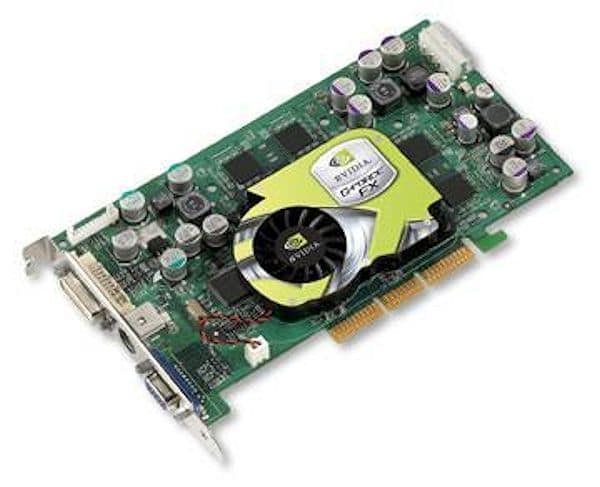Review ABIT SILURO FX 5600 Ultra DT 128 MB: Overclocking | Pros & Cons| Best CPU performance – Review of video adapter ABIT SILURO FX 5600 Ultra DT 128 MB – Today a new guest appeared in our test laboratory – the ABIT SILURO FX 5600 Ultra DT 128 MB video adapter. Its heart is the NVIDIA GeForce FX 5600 aka NV31 chip, architecturally similar in many respects to the failed NV30, but intended for mass video adapters. Here are the characteristics of this VPU:
0.13-micron process technology;
AGP 8x support;
Stage fill rate: 1.4 gigatexels / sec .;
Vertex processing speed: 88 million vertices / sec;
CineFX technology: support for pixel and vertex shaders 2.0+;
Intellisample technology;
Multi-monitor support (nView technology);
NVIDIA Digital Vibrance Control 3.0;
Two RAMDACs with a frequency of 400 MHz;
Can overlay 16 texels per pixel, with eight textures per clock;
4 rendering pipelines with 1 TMU each, the ability to work in 4×1 and 2×2 modes (pipelines x TMU);
The architecture is optimized for the Cg language;
New 64-phase video stream scaling method;
Video Mixer Renderer (VMR) support;
Supports hardware decoding MPEG-2;
Supports TV-out with anti-flicker function;
DVI-I support, up to 1600×1200;
Quite an impressive list. The most interesting thing is that we got a copy based on the old revision of the chip, operating at 350 MHz with Hynix memory (2.8 nanoseconds) operating at 350 (700) MHz. At present, NVIDIA is actively promoting a new version of the GeForce FX 5600 Ultra, in which the chip, which changed the packaging type to FC-PGA, operates at 400 MHz, and the memory – at 800 MHz. Looking ahead, we will say that our sample also performed excellently at these frequencies. We were able to conduct a full cycle of tests in this mode and find out how much the new revision is faster than the old one.
Taking the card in his hands
We got the ABIT SILURO FX 5600 Ultra DT video adapter in a full retail package, including the box, which we will first tell you about. This is not to say that the box is ugly, but against the background of many competitors’ products it looks, frankly, pale: blue-black-and-white tones with an incomprehensible pattern resembling frescoes of the Maya Indians do not attract the eye in a circle in the center. Here’s what we found in the above box:
Video adapter ABIT SILURO FX 5600 Ultra DT 128 MB – 1 pc .;
User manual – 1 pc .;
Disk with drivers and utilities – 1 pc .;
CD with demo versions of various software – 1 pc .;
Splitter type Molex – 1 pc. (in a protective blue sheath);
Adapter DVI-I -> D-Sub – 1 pc .;
S-Video -> RCA adapter – 1 pc .;
RCA cable – 1 pc .;
S-Video cable – 1 pc .;
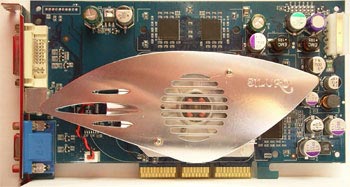
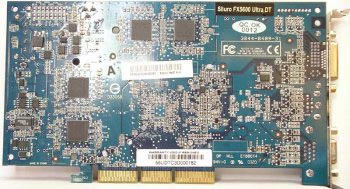
The video adapter itself makes a completely different impression than the box in which it is packed – the card is very beautiful, and the silvery color of the cooling system in combination with the dark blue color of the PCB will delight the eyes of any esthete.
The extraordinary simplicity of the PCB immediately catches your eye: an unusual emptiness reigns in the left part of the card, which is covered, however, by a silvery petal of the cooling system. Under it you can see the place for the Philips chip, which is responsible for the video input functions. In this model, there are no video input functions, and the corresponding place is empty. The right side of the board seems to be made according to the reference design, since the arrangement of the elements practically coincides with that which can be seen on the reference board from NVIDIA. The Molex-type power connector is very well secured: it is surrounded by a metal clamp, which is tightly soldered into the board. It will be very difficult to damage such a connector. It is curious that ABIT engineers apparently planned to install heatsinks on memory chips; in any case, the mounting holes and markings on the PCB are present. Inexplicably,
As for the cooling system, it is extremely simple – an ordinary aluminum radiator with rather thin fins is equipped with a small fan and covered with a protective grill, the shape of which is rather difficult to describe – this is a petal with slots on the left and engraved “SILURO” on the right. All this economy is fastened using two ordinary plastic spring clips. The contact between the heatsink and the VPU is good; a layer of thermal paste is visible through the light. And, of course, there were some fashionable modder tricks: the fan has transparent blades and is illuminated during operation with a bright blue LED. There is not much sense in this, because all AGP boards in standard cases face downward with fans, so this backlight will only illuminate the first PCI device. However, fashion is fashion, it does not require a logical explanation.
The cooling system does its job well, but it makes quite a lot of noise. As for the reverse side of the PCB, it is very complex – there are many small elements on it. The installation is very accurate, although some of the details, apparently responsible for organizing the video input, have not been installed. There is also a black sticker with the name of the video adapter and an etched silver inscription with a certain number. The workmanship of the product made a favorable impression on us, and we can confidently state that this is a real ABIT product
SiluroIQ and Graphics Max are useless tools
The driver disc contains 2 interesting utilities – Graphics Max and SiluroIQ. The first of them is a tool for overclocking the video adapter, and the second is a system monitoring program. Frankly, neither the first nor the second satisfied us, since the frequency range in Graphics Max is extremely narrow (375 MHz in the core, which is not enough; 875 MHz in memory, which is normal), and SiluroIQ refused to work at all, which is not surprising , because the hero of our today’s review is not equipped with any means of hardware monitoring. In addition, the same disc also contains the not particularly interesting SiluroDVD DVD player, which is a modified version of InterVideo WinDVD.
The second disc that comes with the video adapter contains a demo version of the Soldier of Fortune II game, the Earth Viewer program – a kind of virtual globe and a special version of Window Blinds that can change the appearance of Windows XP, however, it works only with NVIDIA and ABIT styles set.
Overclocking and 2D quality
This copy of the ABIT SILURO FX 5600 ULTRA DT video adapter was able to work steadily at 415/810 MHz, however, we decided to limit ourselves to 400/800 MHz in order to compare with the new revision of NV31, especially since the 15/10 MHz gain turned out to be almost imperceptible … 2D quality can be described as good, although text blurring was noticeable at 1600 x 1200 x 85 Hz. However, keep in mind that 2D quality test results cannot be called completely objective, as they are highly dependent on a particular monitor instance.
Performance tests: ABIT SILURO FX 5600 Ultra DT versus RADEON 9600 PRO
Today our hero will have to fight with a young competitor in the person of ATI RADEON 9600 PRO, as well as with an aging, but not losing its power, eight-pipelined robust ATI RADEON 9500 PRO. We chose the NVIDIA GeForce FX 5900 video adapter as a reference. As a test bench, we used a system with the following configuration:
Processor: AMD Athlon XP 2600+ “Thoroughbred” (2.083 GHz, 166 (333) MHz FSB);
Motherboard: EPoX EP-8K3A +;
RAM: 512 MB PC3200 (2-2-5 1T, 166 (333) MHz, Corsair XMS3200);
Hard drive: Maxtor DiamondMax Plus D740X (2 MB buffer), 40 GB capacity;
Sound adapter: Creative Soundblaster Live! 1024;
OS: Microsoft Windows XP SP1;
Drivers: VIA Hyperion 4-in-1 v.4.47, ATI Catalyst 3.5 (for cards based on ATI RADEON), NVIDIA Detonator 44.03 (for GeForce FX 5600 Ultra).
The set of test applications remained unchanged:
Futuremark 3DMark 2001SE Build 330
Futuremark 3DMark03
Codecult CodeCreatures Benchmark Pro v1.0
Unreal Tournament 2003 v2225, Antalus Flyby
Quake 3: Arena v1.32, Demo four
Return to Castle Wolfenstein v1.4, Demo checkpoint
Serious Sam: Second Encounter v1.05, The Grand Catherdral
Jedi Knight 2: Jedi Outcast v1.04, Massasi Temple – Lightsaber Test
Splinter Cell v1.2b, 1_1_1Tbilisi Demo
All games were tested in modes with the highest graphics quality. The following resolutions were used: 1024×768, 1280×1024 and 1600×1200. In each of them, each application was tested 2 times – without using anti-aliasing and anisotropic filtering and using four times anti-aliasing and anisotropic filtering on eight samples. Unfortunately, NVIDIA once again fell for the “optimization” of drivers, this time in the Splinter Cell game.
As it turned out, video cards based on the latest generation chips from NVIDIA and ATI Technologies are not able to work correctly with this game in modes with full-screen anti-aliasing enabled; when FSAA is turned on, you can easily notice artifacts, most often manifested in the fact that light sources shine through walls that are opaque by definition. However, the companies’ approach to the problem turned out to be different, albeit equally wrong: ATI Technologies simply ignored the problem, leaving everything as it is, but NVIDIA once again applied its favorite trick: it “modified” the drivers so that full-screen anti-aliasing would not be enabled when SplinterCell.exe was launched.
The company again “forgot” to inform users about this, and we have to do this. These artifacts can be seen if you rename the SplinterCell.exe file and start the game with AA enabled: The company again “forgot” to inform users about this, and we have to do this. These artifacts can be seen if you rename the SplinterCell.exe file and start the game with AA enabled: The company again “forgot” to inform users about this, and we have to do this. These artifacts can be seen if you rename the SplinterCell.exe file and start the game with AA enabled:
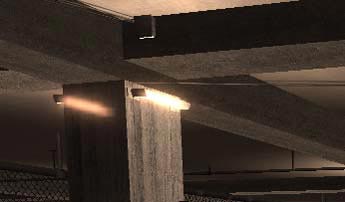
Or such:
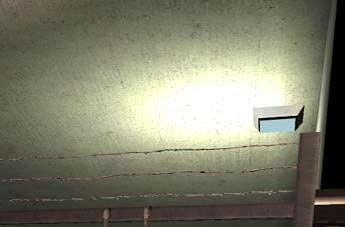
Or even these:
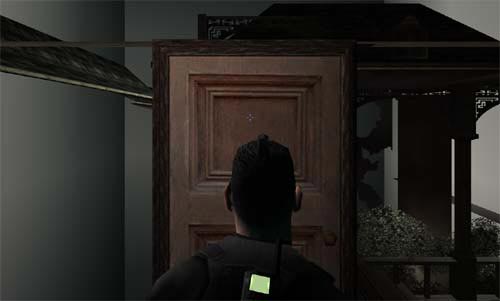
Thus, we have to admit that the test results in SlinterCell are not correct, despite the fact that the performance of GeForce FX in this game drops very realistically when AA is enabled; we recommend our readers to compare only video adapters based on chips from the same manufacturer – ATI versus ATI, NVIDIA versus NVIDIA. However, let’s move on to the test results: OpenGL Game Tests
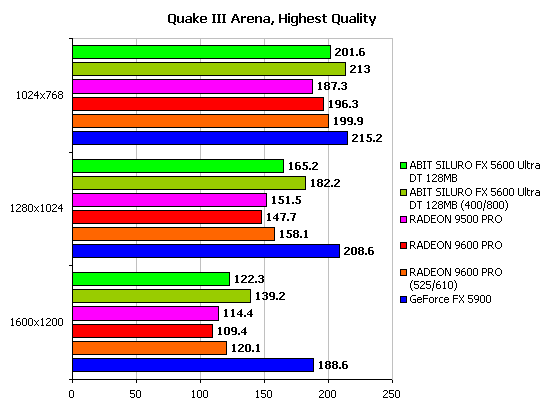
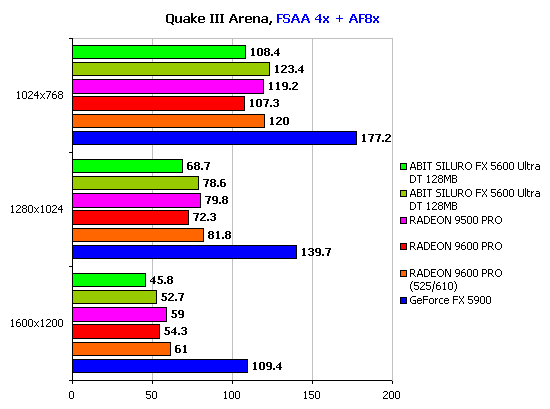
We can say that Quake and SILURO FX 5600 Ultra DT are made for each other: the overclocked ABIT product outperforms ATI RADEON 9600 PRO in all tests, and when overclocked, the gap grows even more. Overclocked to almost sky-high frequencies, the RADEON 9600 PRO catches up with the FX 6500 Ultra DT only in load modes. The RADEON 9500 PRO performed surprisingly well, operating at much lower frequencies (275/540 MHz). However, one should not be surprised: his eight-conveyor “musculature” allows him to keep on an equal footing with competitors in the most difficult modes.
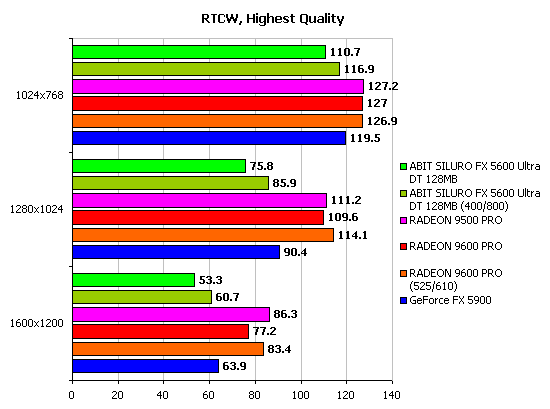
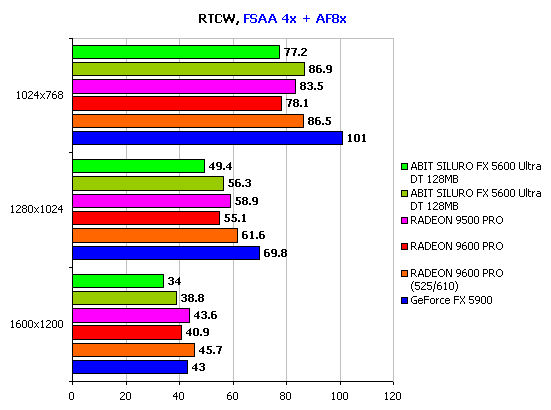
Return To Castle Wolfenstein, on the other hand, prefers video cards from ATI Technologies: SILURO FX 5600 Ultra DT loses with a crushing score in no load mode, and only FSAA and AF enable it to almost catch up with its rivals. The RADEON 9500 PRO shows excellent results here as well.
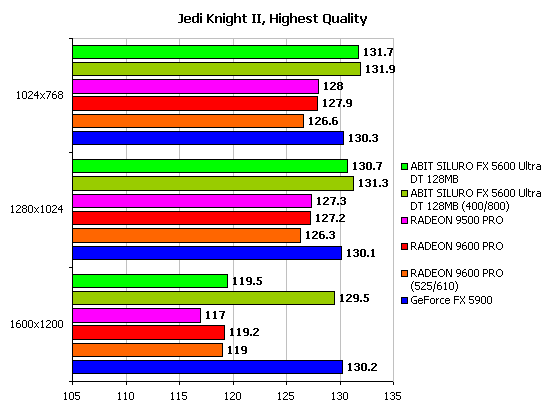
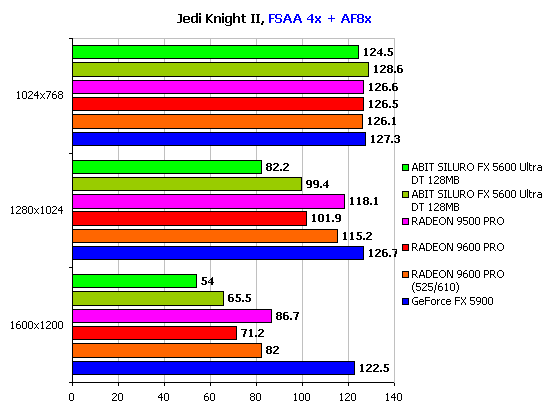
In Jedi Knight II everything looks exactly the opposite: the SILURO FX 5600 Ultra DT wins by a significant margin in easy modes, and immediately loses its positions in difficult modes, where the battle-tested RADEON 9500 PRO shows itself best of all.
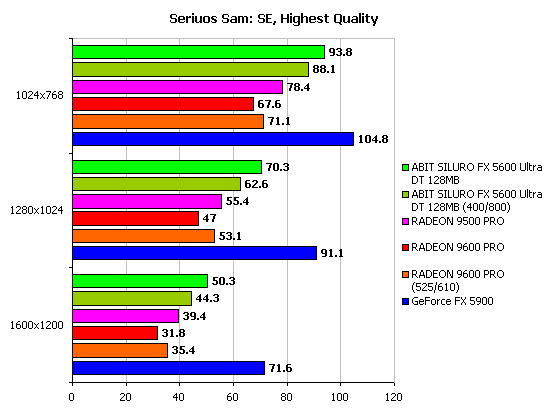
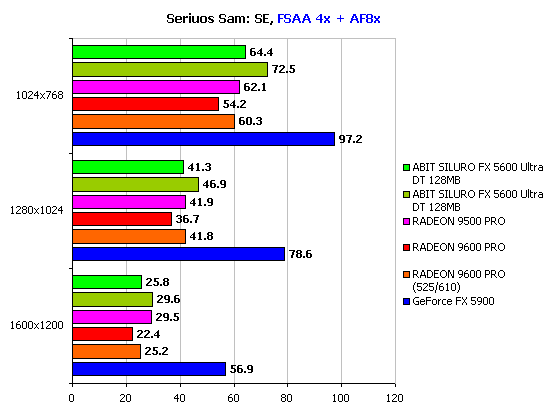
Serious Sam: The Second Encounter with its original engine shows the following picture: in easy modes the ABIT product wins, but in heavy modes the same ubiquitous RADEON 9500 PRO gradually starts to catch up with it, which manages to equalize the score in 1600 x 1200 resolution. remains with SILURO FX 5600 Ultra DT. Direct3D gaming benchmarks
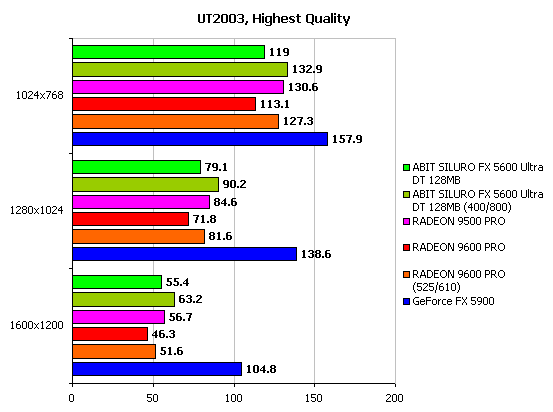
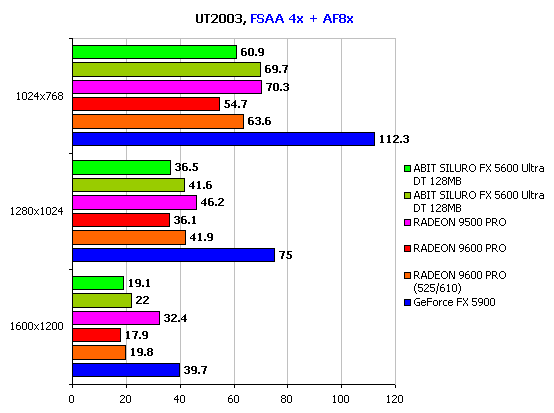
In this game with a very beautiful engine, the presence of eight pipelines or fast memory becomes vital: in light modes the SILURO FX 5600 Ultra DT wins, but in heavy modes the RADEON 9500 PRO again “flexes”. The overclocking of the RADEON 9600 PRO also bears fruit.
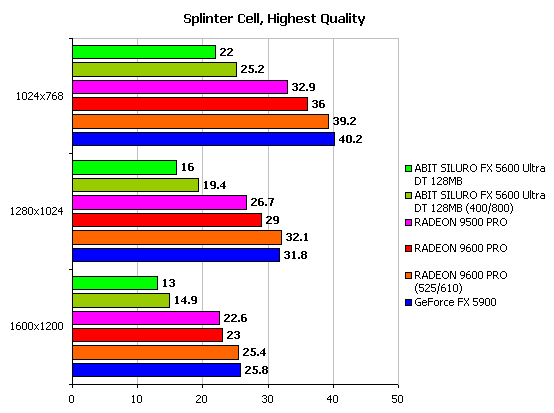
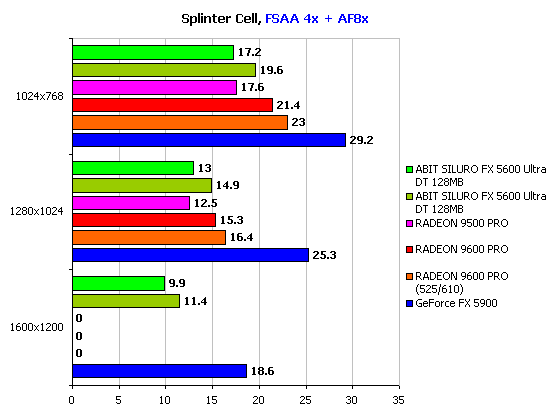
So it came to the hardest game in our review. Splinter Cell easily brings even the most powerful video adapters with powerful shader units to its knees, not to mention the GeForce FX with its weak ALUs. SILURO FX 5600 Ultra DT loses everywhere, and overclocking does not save the day. Moreover, the RADEON 9600 PRO, operating at higher frequencies, is on a par with the much more expensive GeForce FX 5900. We remind you that the tests in modes with anti-aliasing and anisotropic filtering cannot be considered correct for the reason given at the beginning of the Performance Tests chapter, however , you can see that the SILURO FX 5600 Ultra DT version operating at 400/800 MHz shows a higher speed than the low-frequency version. Synthetics: 3DMark 2001SE, 3DMark03 and Codecreatures
Let’s see how the hero of today’s review performs in synthetic tests.
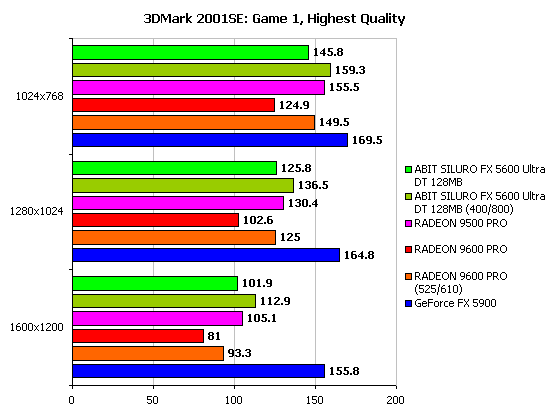
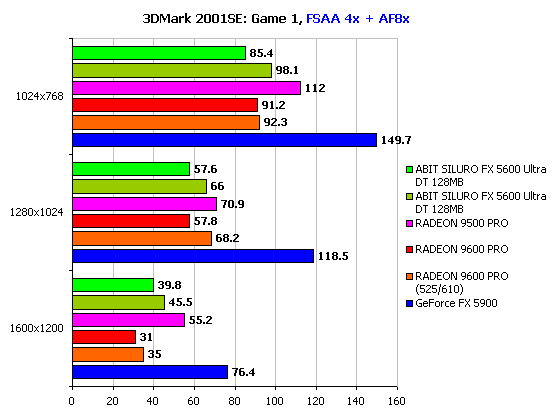
In the first test (races), the ABIT SILURO FX 5600 Ultra DT shows good performance in light modes, where even the RADEON 9500 PRO falls behind the frequencies increased to 400/800 MHz. However, when anti-aliasing and anisotropic filtering are enabled, the eight-pipe architecture of this video adapter makes it a leader. The unclocked SILURO either lags behind or catches up with the overclocked RADEON 9600 PRO.
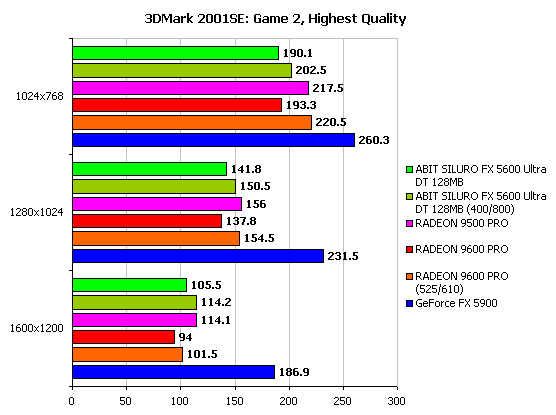
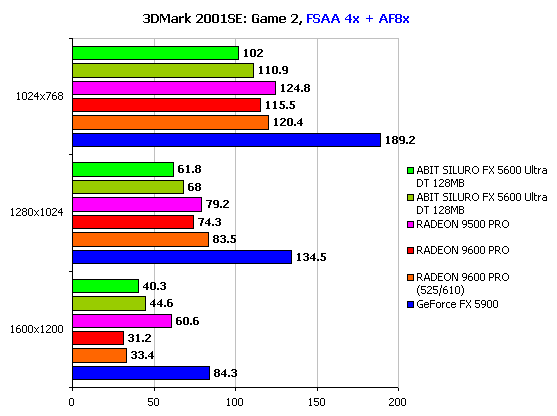
In the second game test (flying a dragon) in no load mode, the places were distributed as follows: the RADEON 9500 PRO leads, followed by the overclocked RADEON 9600 PRO, and the third place is confidently taken by the SILURO FX 5600 Ultra DT, which even manages to catch up with the RADEON 9500 PRO. When FSAA and anisotropic filtering are enabled, the RADEON 9500 PRO takes the first place, followed by the overclocked RADEON 9600 PRO and the same SILURO FX 5600 Ultra DT, which again manages to outperform the RADEON 9600 PRO at 1600 x 1200.
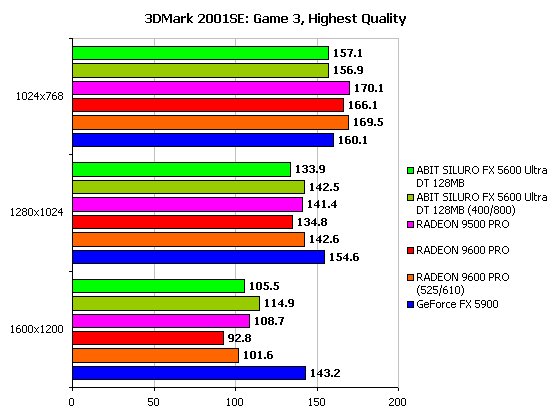
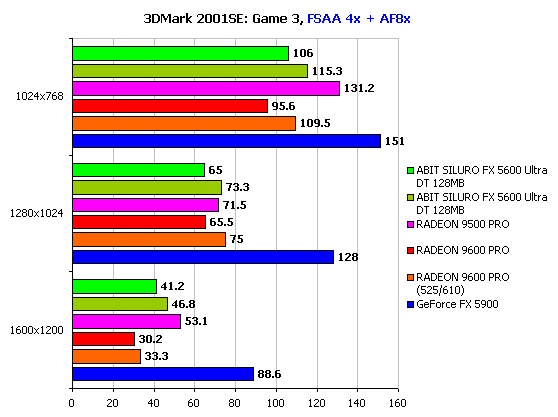
In the third game test of the 3DMark 2001SE package (Matrix), SILURO FX 5600 Ultra (400/800 MHz) video adapters and the same RADEON 9500 PRO perform best.
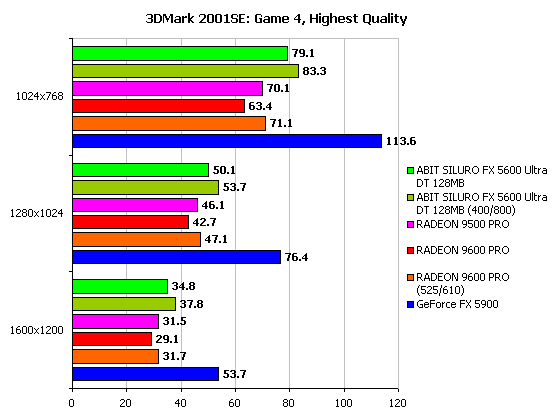
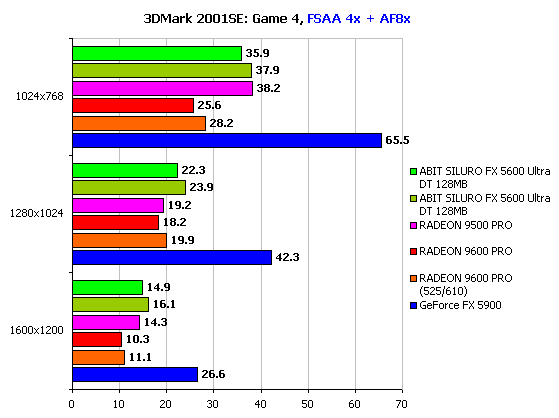
In the fourth game test (Nature) the SILURO FX 5600 Ultra DT (both variants) and RADEON 9500 PRO perform best. The overclocked RADEON 9600 PRO looks good in the easy mode. Moving on to the more modern 3DMark03 benchmark suite:
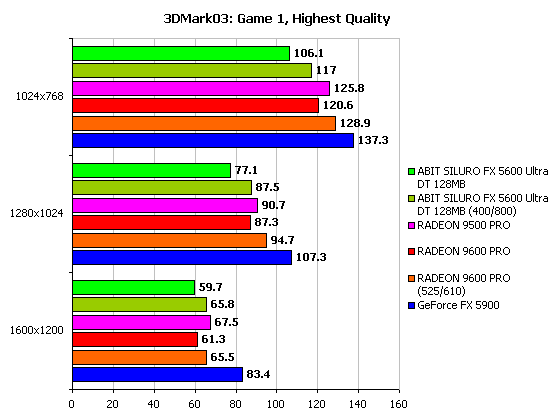
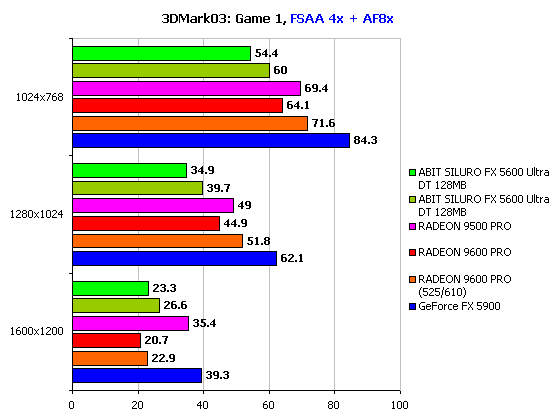
In the first gaming test of this package (flight simulator), video adapters from ATI Technologies show the best results. Overclocking SILURO FX 5600 Ultra DT somewhat corrects the situation, but only in modes without FSAA and anisotropic filtering.
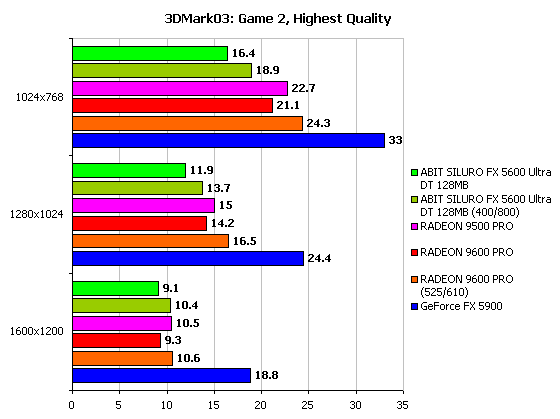
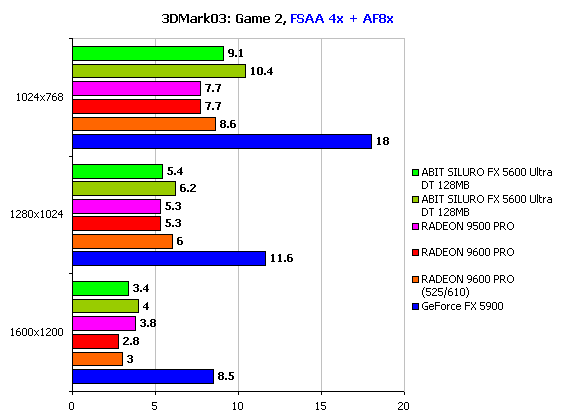
The second gaming test (three-dimensional shooter) shows that ATI cards and the overclocked SILURO FX 5600 Ultra DT show their best in light mode, but in heavy mode it also comes out ahead, apparently due to high frequencies and efficient memory subsystem. Besides, it is known that the chips used in the GeForce FX line perform shaders of the old versions not much worse than the competitor’s chips.
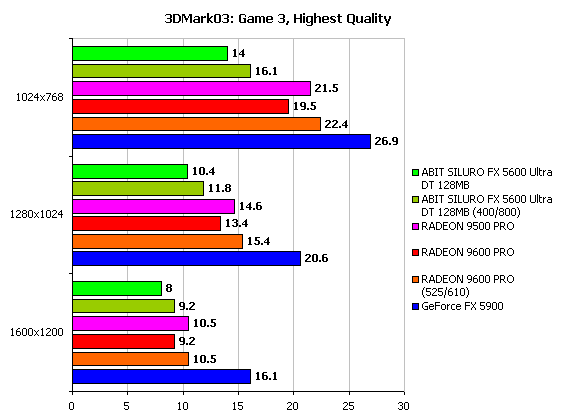
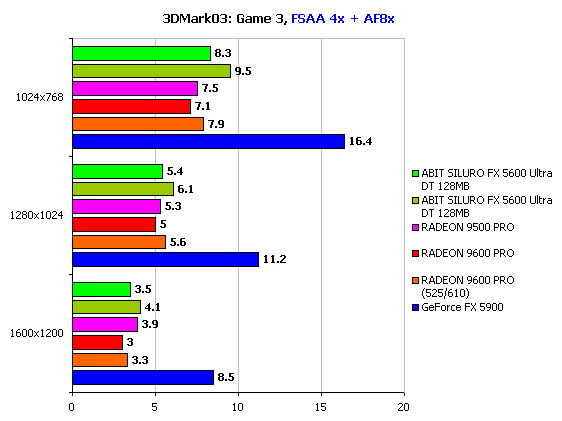
A similar picture is observed in the second game test (something like a third-person RPG). The advantages of the NV31 architecture are clearly seen in heavy duty, and the disadvantages in light duty.
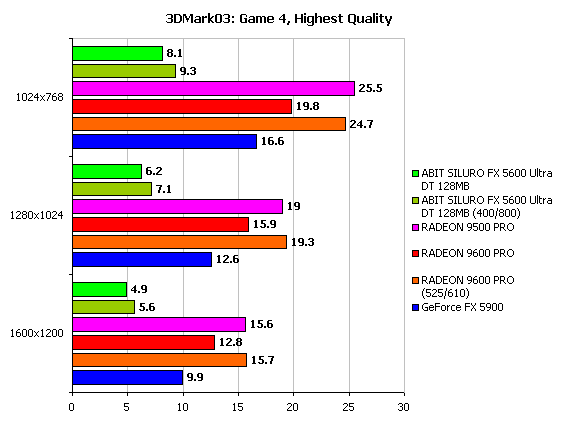
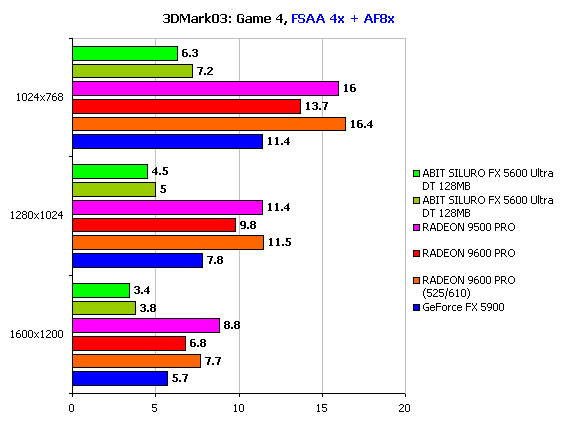
The fourth gaming test 3DMark03, the famous “Mother Nature”, once again becomes a nail in the coffin of the weak ALU NVIDIA GeForce FX chips. A complete and unconditional victory for ATI Technologies and its approach to the execution of shaders 2.0, which are part of the DirectX 9.0 capabilities! Even the GeForce FX 5900 is far behind the video adapters based on the chips of the Canadian developer. The most confident in this test is the same RADEON 9500 PRO. Yes, it looks like ATI cut the number of pipelines in the RV350 to four in vain, because only the overclocking of the RADEON 9600 PRO allows it to catch up with its predecessor.
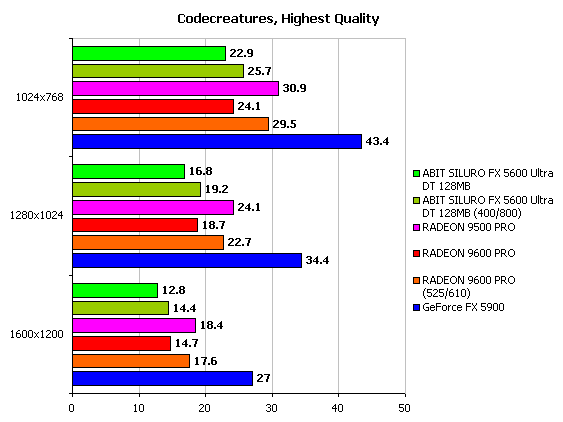
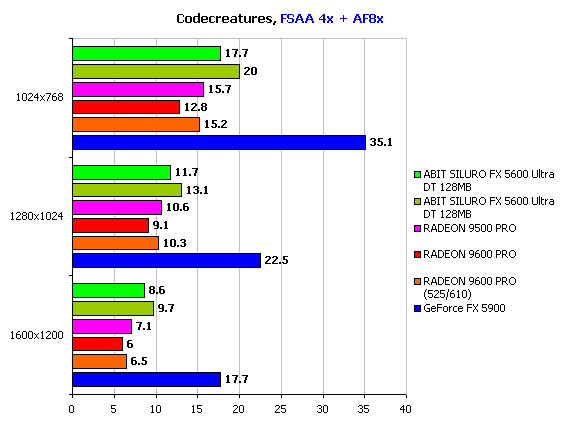
Beautiful and incredibly complex geometrically, the Codecreatures test shows us the following picture: ATI cards, especially RADEON 9500 PRO, run in no load modes. With anisotropic filtering and anti-aliasing enabled, SILURO FX 5600 Ultra DT comes out ahead. Unfortunately, the speed of all accelerators in this test is so low that it is unlikely that a small advantage can be considered seriously, since it is already clear that playability cannot be achieved in any case.
Conclusion
So, we have tested the ABIT SILURO FX 5600 Ultra DT video adapter. The product made an extremely good impression on us. The only thing that can be found fault with is, perhaps, the unsightly design of the box and the poor bundle. In place of the interesting, but very few people need Earth Viewer program and practically useless utility Window Blinds, the full version of the same game Soldier of Fortune II would look much better.
We did not have any other complaints about this product: the beautiful color of the PCB and the cooler, the fan illumination, the high quality of the product and even the presence of high-quality cables and adapters in the set can cause positive emotions in anyone. Good overclocking potential can also draw attention to this product for such a category of buyers as overclocker enthusiasts.
As for the performance, it is more than sufficient for the vast majority of modern games, and only weak ALUs, unable to work quickly with shaders 2.0, can make you think about the prospects of NV31 and the expediency of purchasing ABIT SILURO FX 5600 DT with a view to the future. In games of the new generation, this video adapter will obviously outperform products based on chips from ATI Technologies. However, this applies to the entire GeForce FX line. In general, ABIT SILURO FX 5600 Ultra DT is a good candidate for your attention (and money), but the package bundle could be richer.
ABIT SILURO FX 5600 Ultra DT: advantages and disadvantages
Advantages:
High quality workmanship
Efficient cooling system
Backlighting of the cooler (blue LED)
Good overclocking potential, ensuring stable operation at 400/800 MHz frequencies “new” for GeForce FX 5600 Ultra
High performance in modern games and applications
Flaws:
Lack of heat sinks on memory chips with mounting holes
Ugly box
Poor delivery set





